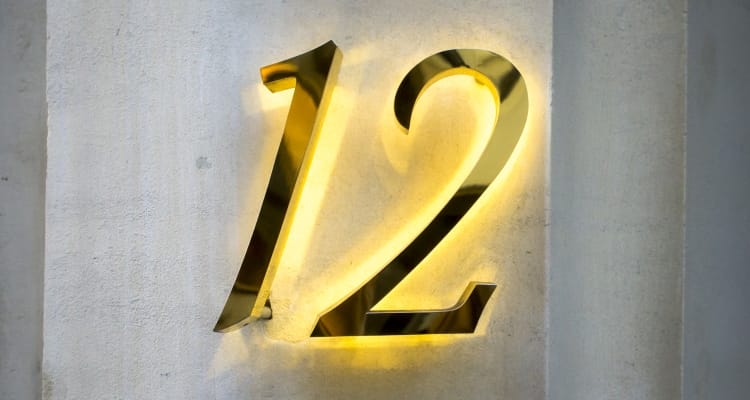Why Twelve?

Why Twelve? – The Significance of the Number
by William Bezanson
Have you ever noticed how dominant the number 12 is? There are 12 months in a year, 12 signs of the zodiac, 12 inches per foot, 12 people on a jury, 12 grades in most school systems, 12 items in a dozen, and so on.
There are many other instances of the number 12 that are common in western civilization. Further, there are many remarkable mathematical properties of twelve that I have not mentioned. In addition, there are many instances of twelve in the Bible, which forms a cultural and mythological basis for western society.
Why is the number 12 so dominant in the world or at least in western culture? Why did humanity not pick the number 10 to be the dominant one, or 4, or 7, or 60, each of which could be supported for significance? What I am seeking is some unique property of twelve or of the abstract notion of twelveness that makes that specific number the only candidate for dominating among its peers. What makes twelve stand out?
What Elst Says About Twelve
These questions stayed on my back burner with the heat on low, but never turned off for many years. Then, along came Google. What a wonderful tool for research! I asked Google one day, “Why Twelve?”, and was led to a very satisfying answer. The top result was a paper with that title by the modern Belgian philosopher Koenraad Elst. What a thrill it was to find it!
Elst explains that the most natural way to divide a circle is into twelve equal parts. Most natural references that it is able to be divided without any external aids other than a compass and a straightedge ruler. These two tools were the only ones permitted by the classical Greek mathematicians. No calculations are permitted, no measuring, no protractors, nothing else.
Circles and the Number Twelve
First, Elst has us draw a circle, using a compass. Then, with the compass still set to the same radius as for that circle, draw another circle with its center anywhere on the circumference of the original circle. Next, using the two points where the circles intersect, draw two more circles, still with the same radius, and repeat that process using each point of intersection of circles with the original circles, so that you have six circles arranged symmetrically around the original circle.
We now have six intersection points arranged uniformly around the original circle, so the points are necessarily spaced by 60 degree intervals (360/6). Now join each of those intersection points to the original circle’s center with straight lines using the straightedge ruler. Finally, note that each of the outer circles intersects its two neighboring outer circles. Draw a straight line from each of those intersection points to the center of the original circle.
Notice how those last lines exactly bisect the angles between the pairs of earlier lines. Thus, each angle between adjacent lines is 30 degrees (60/2). There are 12 of them, spread uniformly around the circle. Consequently, the circle has been divided into twelve equal segments by remarkably natural means, namely, the classical, pure methods used by the ancient Greek geometricians. No fancy computations or measurements were done. Everything was very natural.
As for Elst’s suggestion that this is the most natural way to divide a circle, such a suggestion is appealing, but it is open to speculation. I tend to believe it, but I have not yet been able to prove it. I will prove it or try to find a counter example of a more natural way. Also, I need to prove that the original construction results in exactly six circles. But, until then, I find his idea a very attractive explanation of why the number 12 is dominant.
The circle is one of the most fundamental aspects of nature. It symbolizes the fullness of time or the cycle of birth-life-death-rebirth leading to immortality, as in the famous Alchemical symbol of the Ouroboros, the snake circled around eating its own tail. The circle’s shape is the destination of all matter that is drawn together gravitationally – a sphere. Orbits of planetary bodies tend towards the circular, although other influences distort them into elliptical, but at least the tendency is there. We see circles everywhere: our eyes, our finger rings, raindrops (when viewed from below), the Moon and Sun, and so on.
Therefore, it would seem natural for early humans to consider how a circle can be deconstructed. Humans love to take things apart to see how they are made. The circle would be one of the early candidates for such analysis. And Elst’s argument, which I have summarized here, provides a very good basis for humanity’s early understanding that 12 is the natural number to use for dividing up so much of its experience with the circles of life.
Twelve on Other Planets?
I have often wondered if advanced beings on other planets would also adopt the number 12 as a deconstructing factor. For example, would other civilizations on other planets adopt a zodiac of twelve signs? My speculation is “yes, they would do so.”
First of all, circles are very likely universal concepts. Nature everywhere, including on all other planets, would very likely provide similar manifestations of circles as has been the case on Earth: spherical planetary bodies, raindrop shapes, fruits with a round profile, and so on. At least this would be the case if those other locations had the same rules of Physics as we do here, which is highly likely. A similar analysis as given here would very likely lead such civilizations to divide up their circles into twelve parts as we have done.
The number 12 would not be used, of course, on other planets. That number is formed from the Arabic number system based on a decimal, positional notation, which is unlikely to have developed elsewhere, but the notion of twelveness would have evolved, I would guess. The names and textual formulation of the many instances of twelveness would differ widely, but their underlying notion would be the same.
To my way of thinking, 12, twelve or more abstractly, twelveness, is a universal concept that exists everywhere. Why twelve? Because it is our local, concrete instantiation of the abstract notion of twelveness, which underlies the most natural way to divide a circle into equal parts. The circle is the fundamental symbol of life and its processes.
One highly speculative research area for me involves investigating what is the dominant number on other planets. My hope is to find a past-life regression therapist who might collaborate on this project and ask those clients who remember lives on other planets about numbers there or perhaps deep memories of some people may be fruitful. Even more speculative, it may be that alien visitors might be willing to share their numerical experiences. If such investigation is possible, then such scenarios provide at least some hope of testing my hypothesis.
This article is just a start on documenting my ongoing interest in the number twelve and why it is dominant. I plan to expand this article, through further research and writing, and it may possibly become a book on its own.
Click HERE to Connect with your Daily Horoscope!
About the Author
William Bezanson is a retired engineer who has become an author of systems design and world stewardship books. His latest book is I Believe: A Rosicrucian Looks at Christianity and Spirituality. His website is www3.sympatico.ca/bezanson1. He lives with his wife in Ottawa, Canada.
OMTimes Magazine is one of the leading on-line content providers of positivity, wellness and personal empowerment. OMTimes Magazine - Co-Creating a More Conscious Reality









